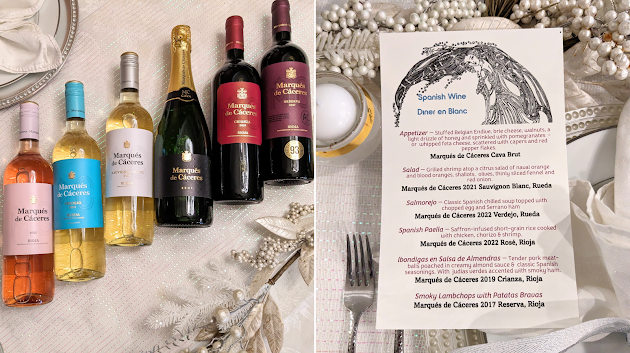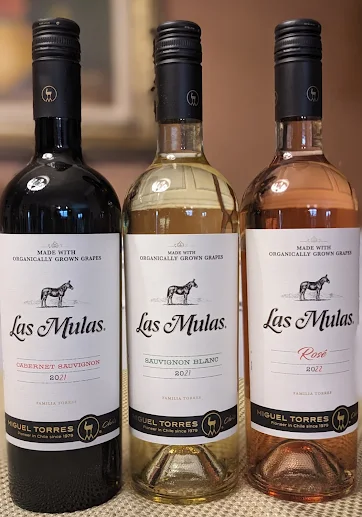Wines from Rioja and Rueda featured at fashionable dinner. Whenever I receive a group of wines to review, we usually gather friends and hold a wine dinner. That was the case with wines we received from the well-known Spanish winery Marqués de Cáceres. My wife, the Green Dragon, decided to add a twist, “We’re going to make this a dinner in white!”
Dîner en Blanc is a worldwide event spanning six continents in which people have a meal dressed in white in a temporary dining setup in a public space. Diners are required to provide their own food, tables, chairs, and tablecloths. So, I guess we properly should have called our event Dîner en Blanc-ish, because we certainly weren’t going to ask our guests to sit outside in January.
This sent me on a quest for things not normally in my wardrobe, like white shoes, white pants, and a white belt. I’m sure our guests faced a similar sartorial dilemma.
Our wine lineup included a Cava, two whites from the Rueda region, and a rosé and two reds from Rioja. Guests at the dinner were asked to choose a wine and prepare a small plate to pair with it.
Marqués de Cáceres was founded by Enrique Forner in 1970. He was exiled to France during the Spanish Civil War and founded a wine business in the Rhône and Loire valleys. He later purchased two chateaux grand cru classé in Bordeaux.
Under the guidance of daughter Christina Forner, who took over the winery operation in 2007, the winery expanded into Rueda and later expanded into Ribera del Duero. Today, the wines can be found in 120 countries, and 50% of the production is exported.
As the crowd gathered and oohed and aahed over the white outfits and the stunning table decorations, we popped open the Marqués de Cáceres Brut Cava. Cava is one of my favorite sparkling wines because it is made in the traditional method, just like champagne. The energetic bubbles and creamy froth added to the festive mood as we munched on delicious Belgian endive and radicchio stuffed with either brie cheese, walnuts, and drizzled honey, or whipped feta scattered with capers and red pepper flakes. Thanks to Ronda and Joe, who traveled from Savannah to attend, for this dish.

The next course featured grilled shrimp atop a citrus salad of naval and blood oranges, shallots, olives, thinly sliced fennel, and red onion. This provided an ideal pairing for the 2021 Sauvignon Blanc from Rueda. Rueda is crafting some of the most interesting white wines in Spain. The rocky soil forces the grapevine roots deep below, digging through sandy, stony soil for water and nutrients. This results in delicious minerality in Rueda wines.
The Sauvignon Blanc is rich and herbaceous with notes of peach and pear. If you are a Sauvignon Blanc fan, give it a try. Alison created this tasty salad.
Verdejo is by far the most planted variety in Rueda. The 2022 vintage we sampled was youthful and tasty with lime and mineral notes with a slight floral accent. The grapes are harvested at night to preserve the fresh flavors. Our next dish, Salmorejo, is a traditional chilled soup made with tomato and bread and has a thick texture. Our dish was topped with chopped egg and Serrano ham. The acidity and refreshing flavor of the Verdejo were perfect to cut through the creaminess of the soup. Gracias to the Green Dragon for this dish.
Expect the unexpected with my good friend Arthur Barham of
Merlot 2 Muscadine and his wife Mary. They transported us to the Spanish seaside with a show-stopping paella of saffron-infused rice cooked with chicken, chorizo, and shrimp. The dish was presented in individual cast iron pans. This popular Spanish dish was matched with the 2022 Rioja rosé. The wine is a delicate pale coral color with intense red berry flavors and great acidity. This was a truly inspired pairing.
As Rueda is known for its white wines, Rioja is recognized around the world for its red wines. The region is a DOCa, the highest quality category in Spanish wine regulation. The harvesting of wine in the area dates back to the time of the Phoenicians. The preeminent grape is Tempranillo with Garnacha a distant second.
The 2019 Rioja Crianza is mostly Tempranillo with small amounts of Garnacha and Graciano. It is aged for 12 months in oak barrels and another year in the bottle. I was pleasantly surprised by its silky texture. It was a grand match with the Ibondigas en Salsa de Almendras, tender pork meatballs poached in a creamy almond sauce accompanied by an assortment of vegetables. Diane and John made this masterpiece that melts in your mouth.
The 2017 Rioja Reserva is a bold wine made only in the best vintages from vines between 45 and 50 years old. The wine is aged for 20 months with an additional two years of bottle aging. The result is a superior wine with solid tannins yet smooth ripe fruit flavors. This wine required something bold, and Green Dragon served up smoky lamb chops with Patatas Bravas (grilled potatoes with a spicy sauce). The strong flavors of the lamb were balanced nicely by this big Spanish red.
Thanks to all our friends for making this a truly fantastic event!
Full disclosure: These wines were received as a marketing sample.













.jpg)










